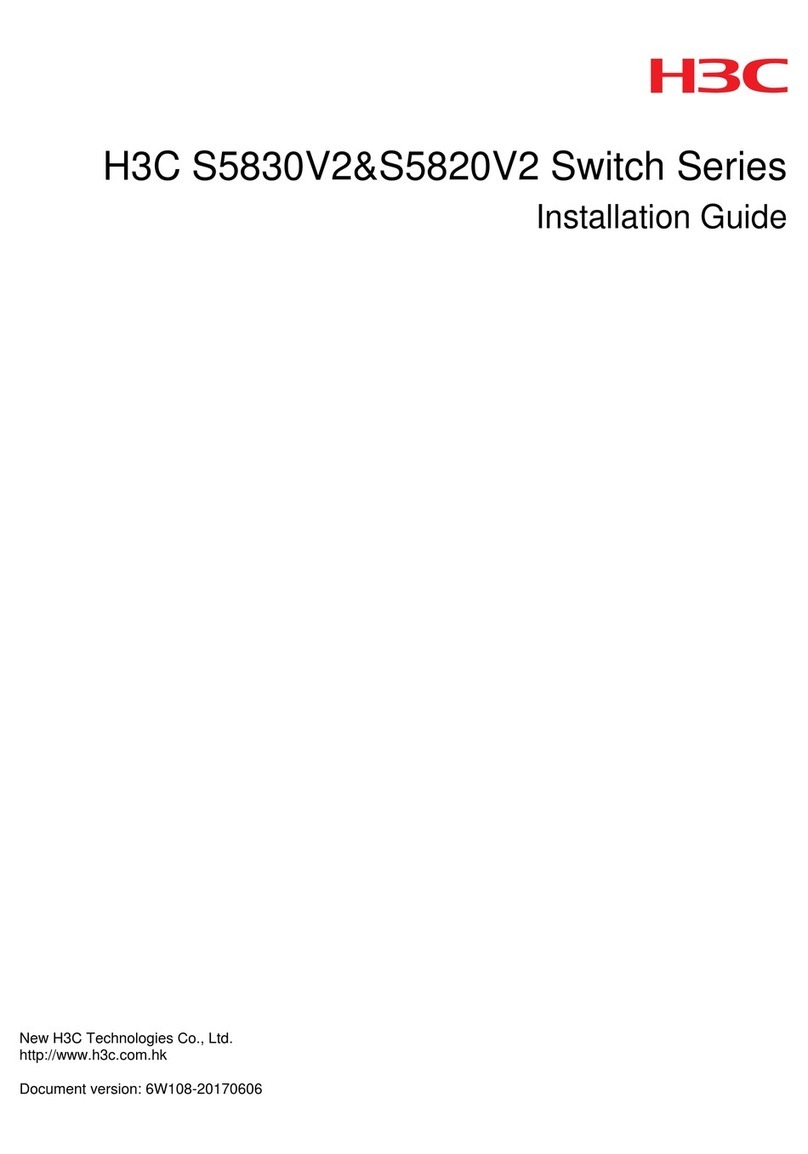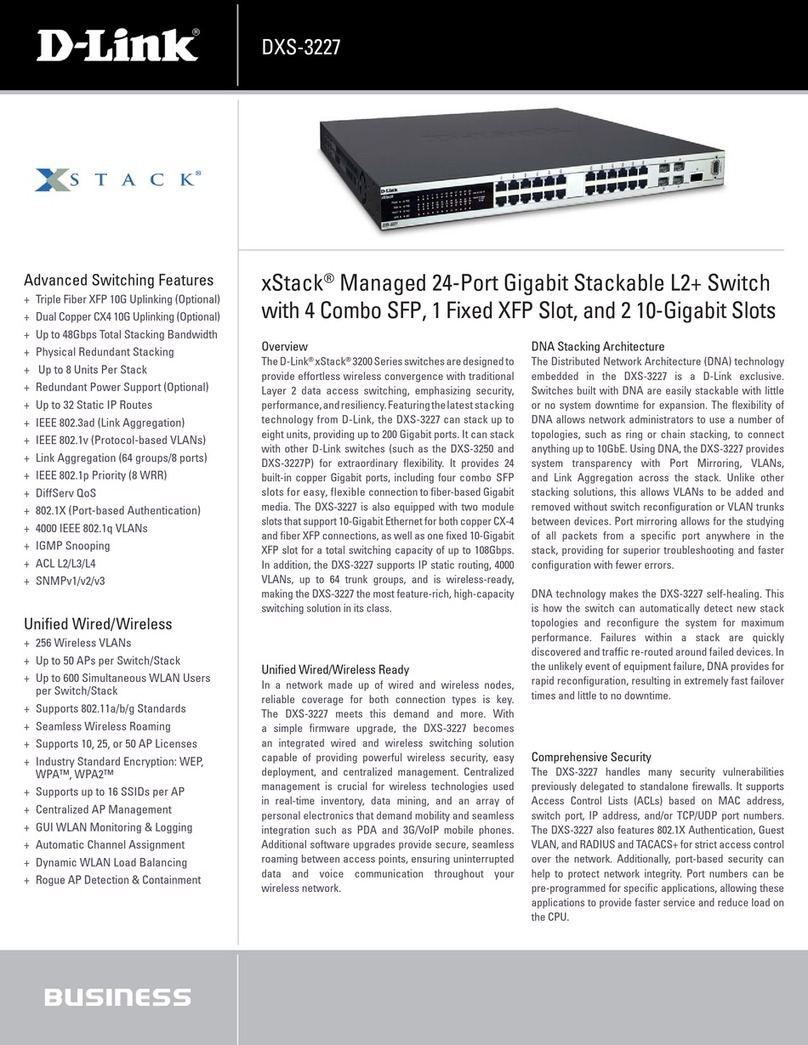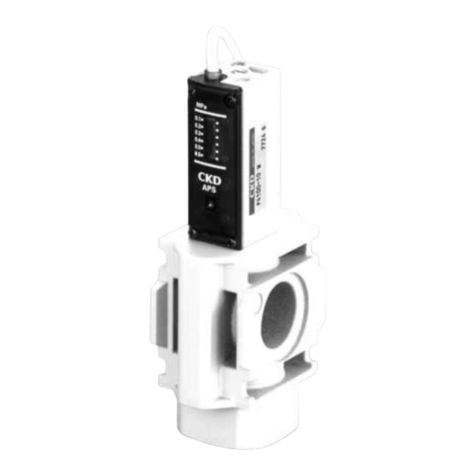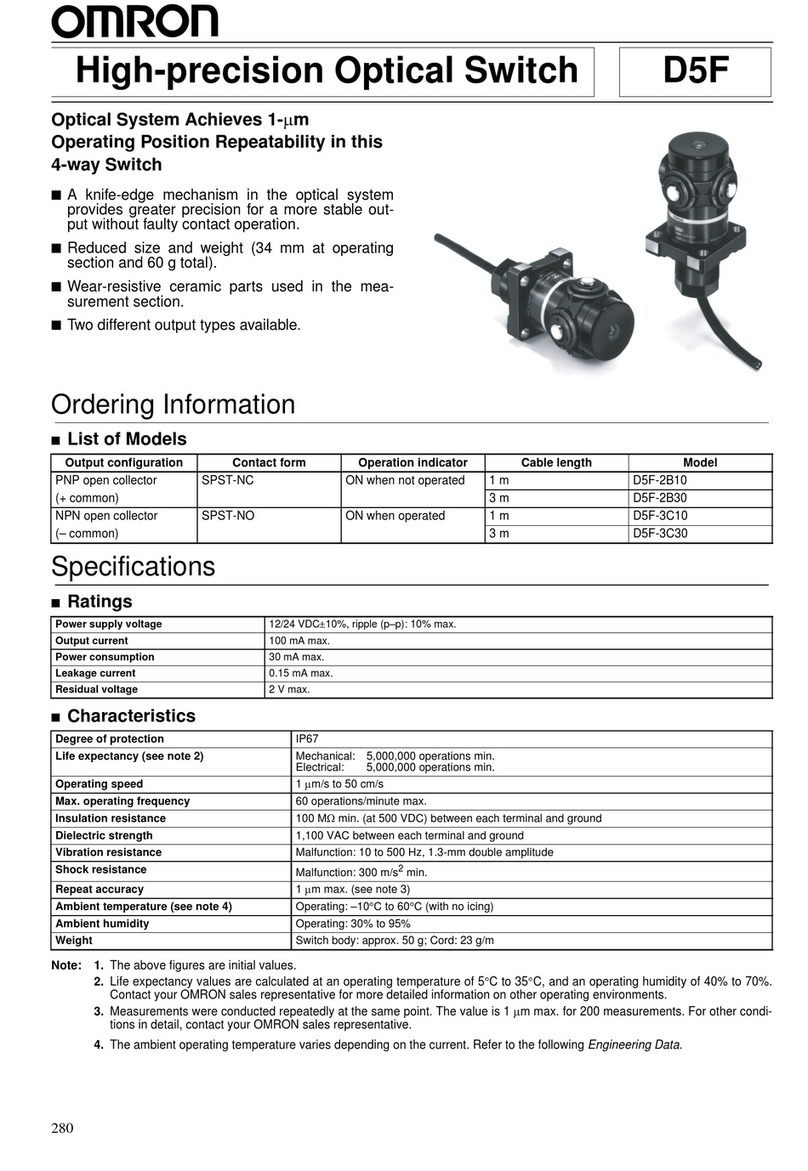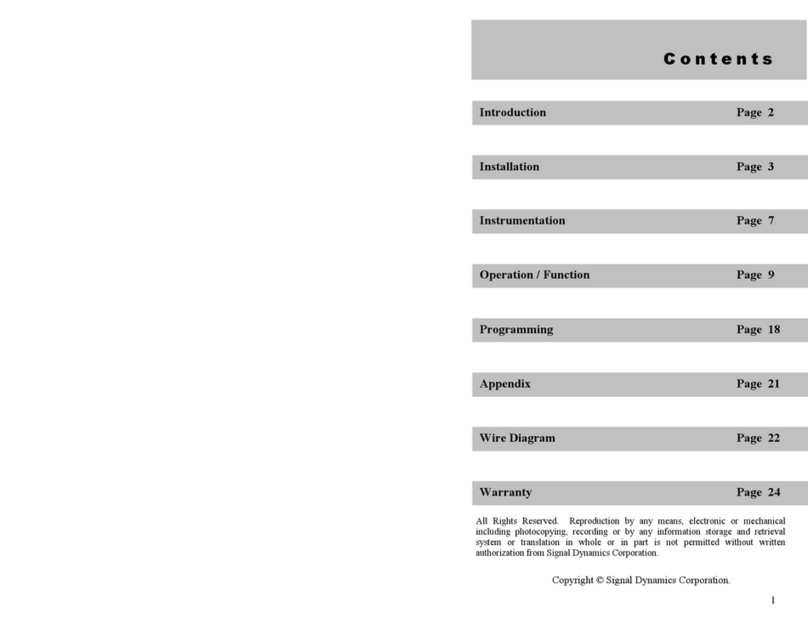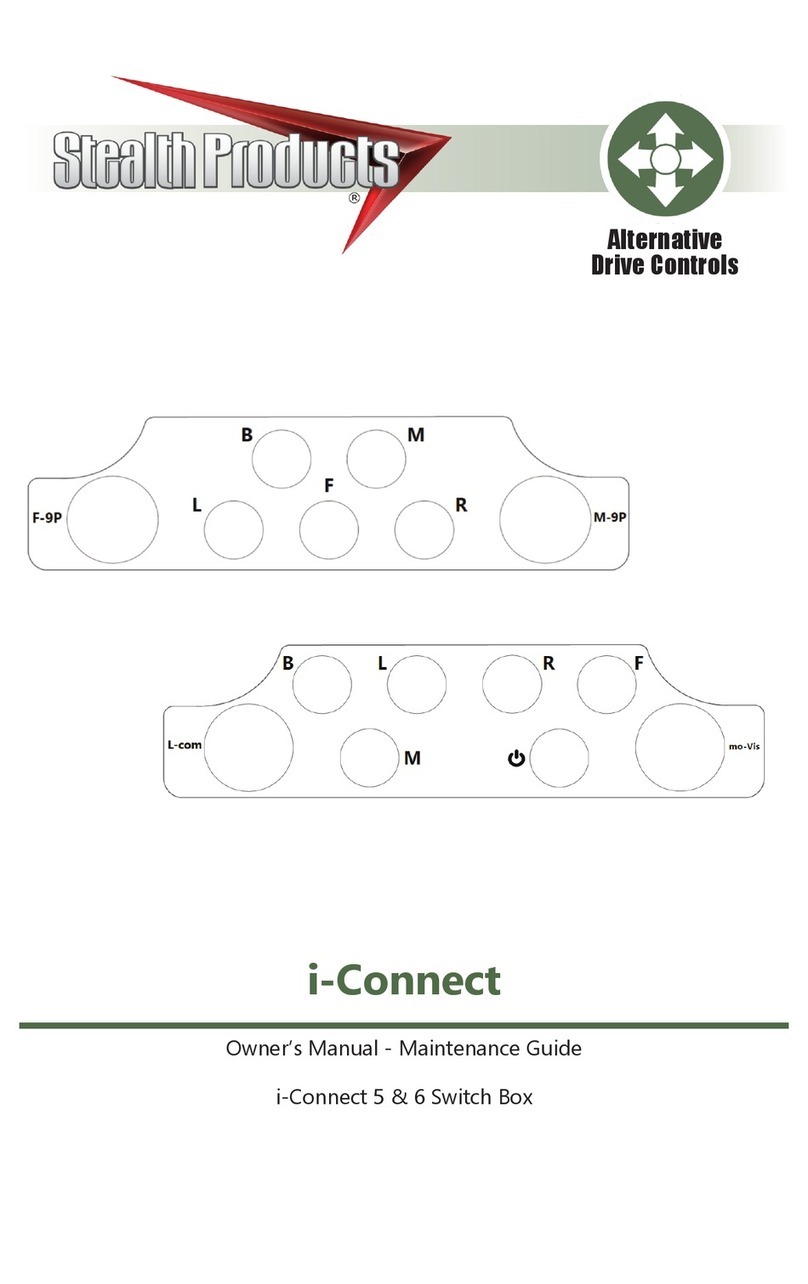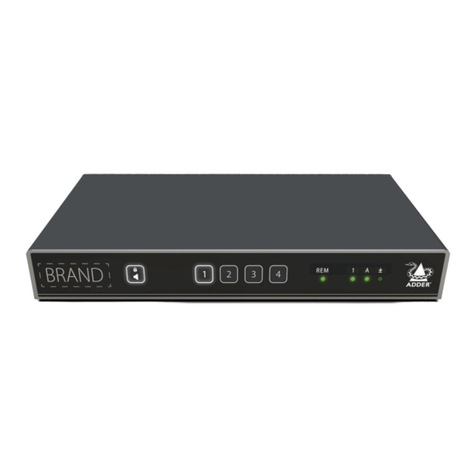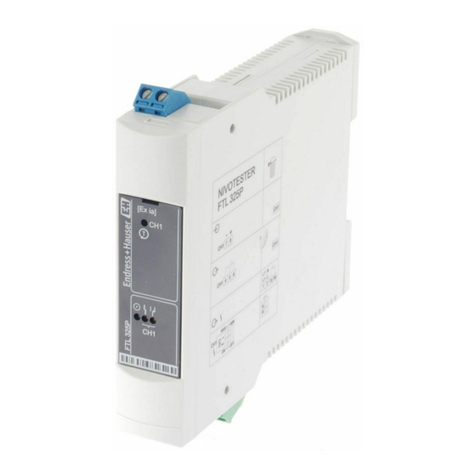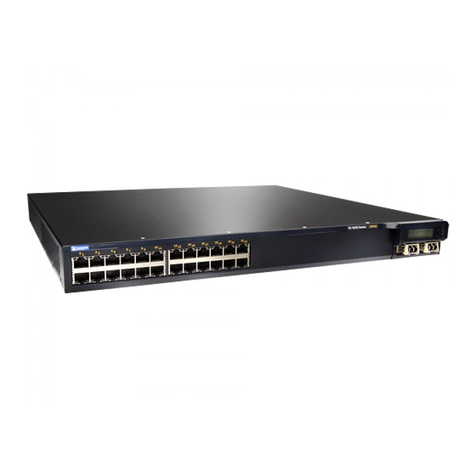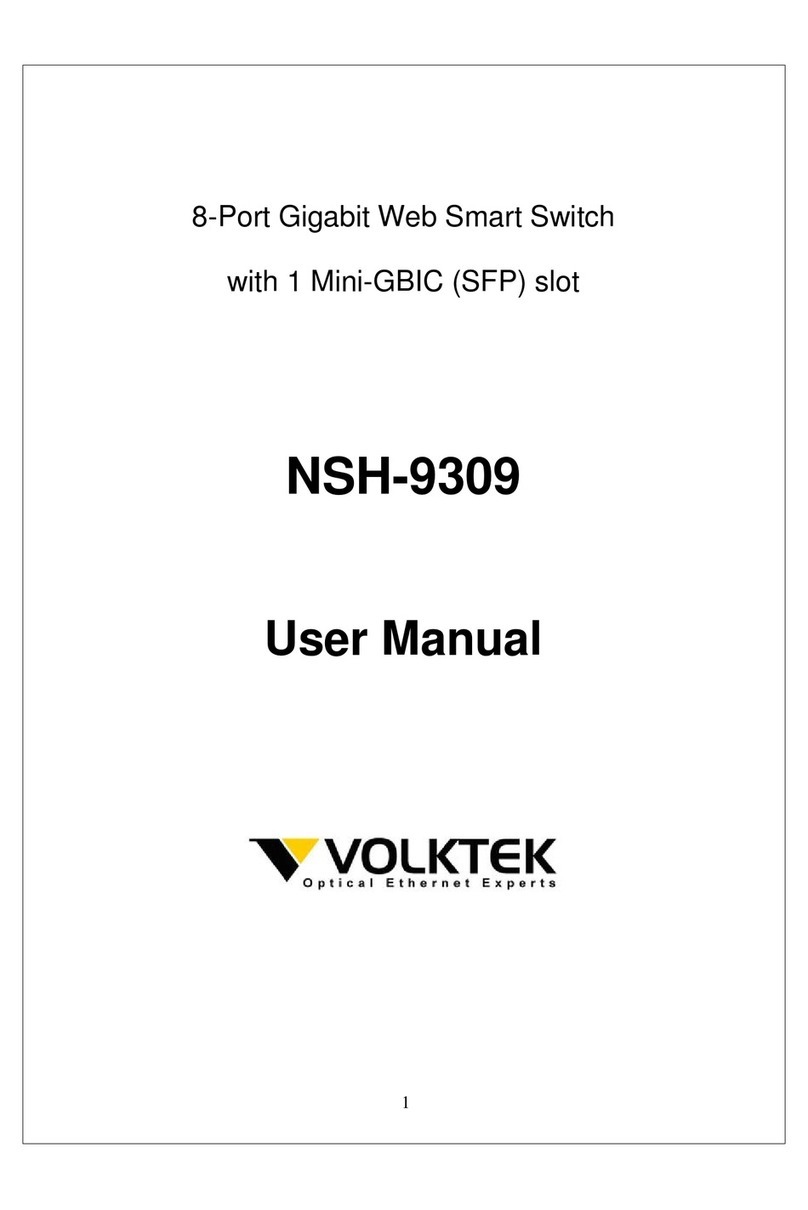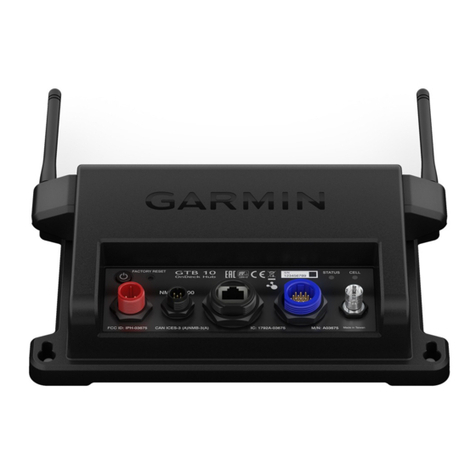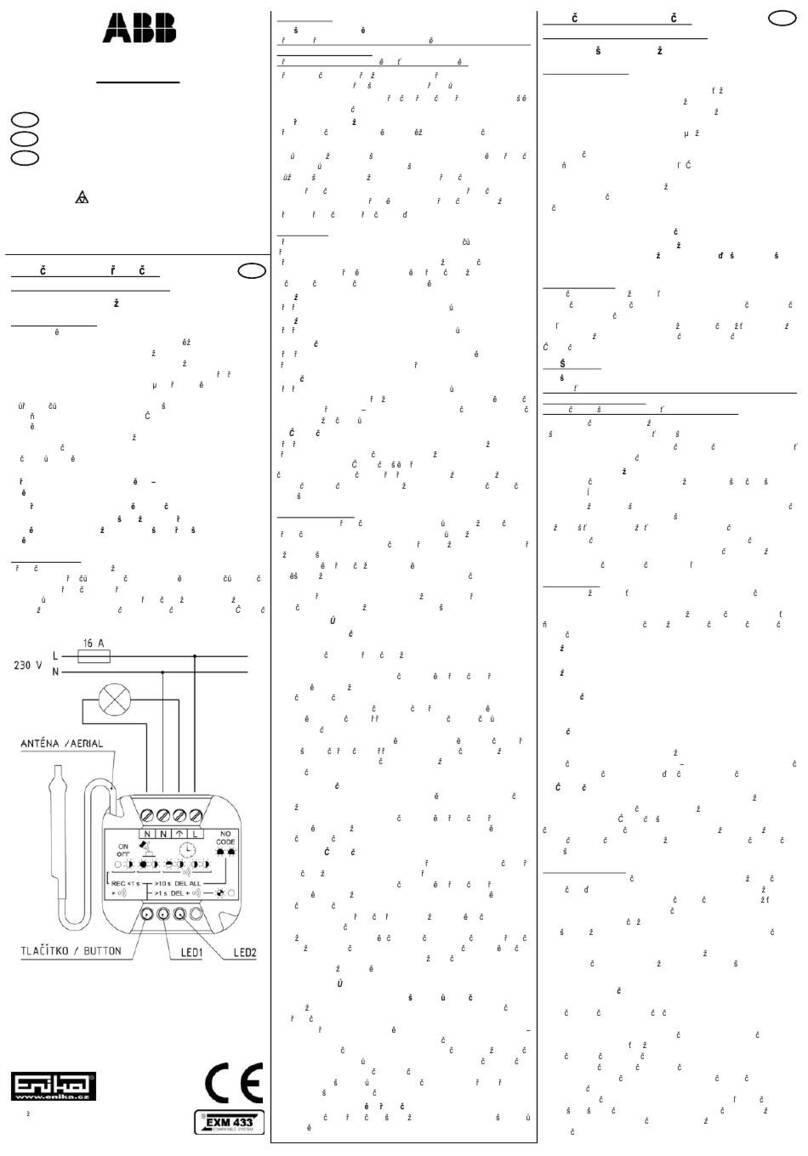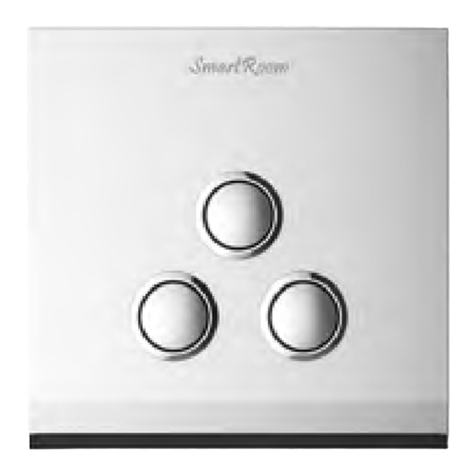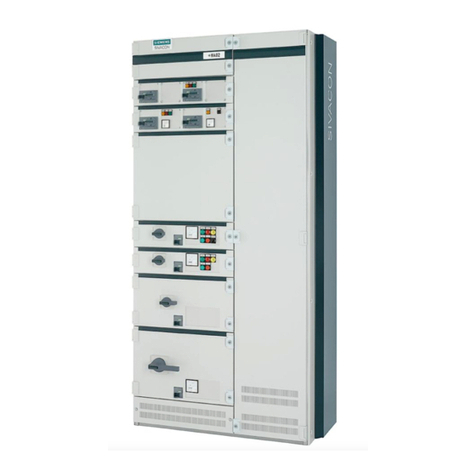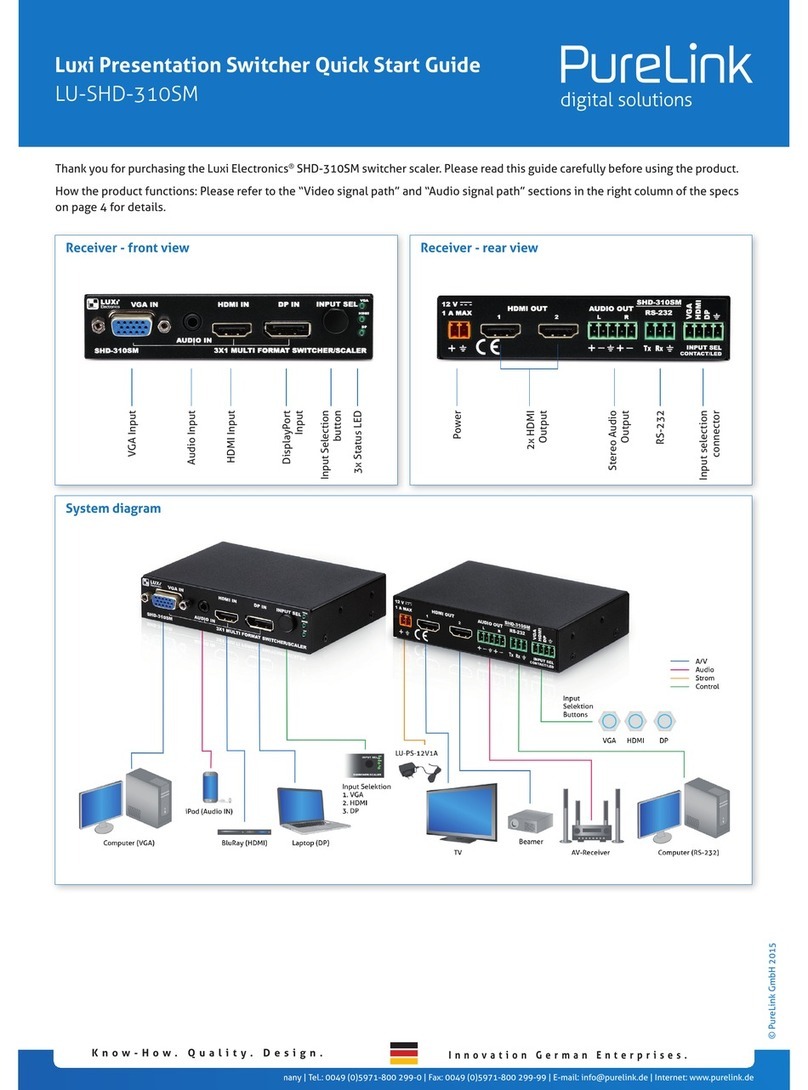H3C S6300 Series Quick guide

H3C S6300 Switch Series
DLDP Configuration Examples
Copyright © 2020 New H3C Technologies Co., Ltd. All rights reserved.
No part of this manual may be reproduced or transmitted in any form or by any means without prior written consent of
New H3C Technologies Co., Ltd.
Except for the trademarks of New H3C Technologies Co., Ltd., any trademarks that may be mentioned in this document
are the property of their respective owners.
The information in this document is subject to change without notice.

i
Contents
Introduction·····················································································1
Prerequisites···················································································1
Example: Automatically shutting down unidirectional links·························1
Network requirements·················································································································1
Software version used·················································································································1
Configuration restrictions and guidelines·························································································1
Configuration procedures·············································································································2
Verifying the configuration············································································································2
Configuration files ······················································································································5
Example: Manually shutting down unidirectional links·······························6
Network requirements·················································································································6
Software version used·················································································································6
Configuration restrictions and guidelines·························································································6
Configuration procedures·············································································································7
Verifying the configuration············································································································7
Configuration files ····················································································································11
Related documentation····································································11

1
Introduction
This document provides DLDP configuration examples.
The Device Link Detection Protocol (DLDP) was developed by H3C to detect the status of fiber
links or twisted-pair links. When DLDP detects unidirectional links, it can automatically shut down
the faulty port to avoid network problems. Alternatively, a user can manually shut down the faulty
port.
Prerequisites
The configuration examples in this document were created and verified in a lab environment, and
all the devices were started with the factory default configuration. When you are working on a live
network, make sure you understand the potential impact of every command on your network.
This document assumes that you have basic knowledge of DLDP.
Example: Automatically shutting down
unidirectional links
Network requirements
As shown in Figure 1, Device Aand Device B are connected through two fiber pairs.
Configure DLDP on the devices so each device performs the following tasks:
•Detects unidirectional links caused by cross-connected fibers or a disconnected fiber.
•Automatically shuts down the faulty interface when detecting a unidirectional link.
•Automatically brings up the interface after the administrator clears the fault.
Figure 1 Network diagram
Software version used
This configuration example was created and verified on S6300-CMW710-R2310..
Configuration restrictions and guidelines
When you configure DLDP, follow these restrictions and guidelines:
•For DLDP to operate correctly, configure the full duplex mode for the interfaces at the two ends of
the link, and configure the same speed for the two interfaces.

2
•For DLDP to operate correctly, enable DLDP on both sides and make sure the following settings are
consistent:
{Interval to send Advertisement packets.
{DLDP authentication mode.
{Password.
Configuration procedures
1. Configure Device A:
# Enable DLDP globally.
<DeviceA> system-view
[DeviceA] dldp global enable
# Configure Ten-GigabitEthernet 1/0/1 and Ten-GigabitEthernet 1/0/2 to operate in full duplex
mode at 10000 Mbps, and enable DLDP on the interfaces.
[DeviceA] interface ten-gigabitethernet 1/0/1
[DeviceA-Ten-GigabitEthernet1/0/1] duplex full
[DeviceA-Ten-GigabitEthernet1/0/1] speed 10000
[DeviceA-Ten-GigabitEthernet1/0/1] dldp enable
[DeviceA-Ten-GigabitEthernet1/0/1] quit
[DeviceA] interface ten-gigabitethernet 1/0/2
[DeviceA-Ten-GigabitEthernet1/0/2] duplex full
[DeviceA-Ten-GigabitEthernet1/0/2] speed 10000
[DeviceA-Ten-GigabitEthernet1/0/2] dldp enable
[DeviceA-Ten-GigabitEthernet1/0/2] quit
# Set the interval for sending Advertisement packets to 5 seconds (default interval).
[DeviceA] dldp interval 5
# Configure the plain text authentication mode and set the password to abc.
[DeviceA] dldp authentication-mode simple
[DeviceA] dldp authentication-password simple abc
# Set the interface shutdown mode to auto (default mode).
[DeviceA] dldp unidirectional-shutdown auto
2. Configure Device B in the same way Device A is configured. (Details not shown.)
Verifying the configuration
# Display global and interface-specific DLDP configuration for Device A.
[DeviceA] display dldp
DLDP global status: Enabled
DLDP advertisement interval: 5s
DLDP authentication-mode: Simple
DLDP authentication-password: ******
DLDP unidirectional-shutdown mode: Auto
DLDP delaydown-timer value: 1s
Number of enabled ports: 2
Interface Ten-GigabitEthernet1/0/1
DLDP port state: Bidirectional

3
Number of the port’s neighbors: 1
Neighbor MAC address: 0023-8956-3600
Neighbor port index: 1
Neighbor state: Confirmed
Neighbor aged time: 11s
Interface Ten-GigabitEthernet1/0/2
DLDP port state: Bidirectional
Number of the port’s neighbors: 1
Neighbor MAC address: 0023-8956-3600
Neighbor port index: 2
Neighbor state: Confirmed
Neighbor aged time: 12s
The output shows that the DLDP port status of both Ten-GigabitEthernet 1/0/1 and Ten-
GigabitEthernet 1/0/2 is Bidirectional.
# Enable the monitoring of logs on the current terminal for Device A, and set the lowest level of the
logs that can be output to the monitor terminal to 6.
[DeviceA] quit
<DeviceA> terminal monitor
The current terminal is enabled to display logs.
<DeviceA> terminal logging level 6
As shown in Figure 2, the two pairs of fibers between Device Aand Device B are cross-connected.
Figure 2 Cross-connected fibers
The following log information is displayed on DeviceA:
<DeviceA>%Jul 11 17:40:31:089 2014 DeviceA IFNET/3/PHY_UPDOWN: Ten-
GigabitEthernet1/0/1 link status is DOWN.
%Jul 11 17:40:31:091 2014 DeviceA IFNET/5/LINK_UPDOWN: Line protocol on the interface
Ten-GigabitEthernet1/0/1 is DOWN.
%Jul 11 17:40:31:677 2014 DeviceA IFNET/3/PHY_UPDOWN: Ten-GigabitEthernet1/0/2 link
status is DOWN.
%Jul 11 17:40:31:678 2014 DeviceA IFNET/5/LINK_UPDOWN: Line protocol on the interface
Ten-GigabitEthernet1/0/2 is DOWN.
%Jul 11 17:40:38:544 2014 DeviceA IFNET/3/PHY_UPDOWN: Ten-GigabitEthernet1/0/1 link
status is UP.
%Jul 11 17:40:38:836 2014 DeviceA IFNET/3/PHY_UPDOWN: Ten-GigabitEthernet1/0/2 link
status is UP.
The output shows that the physical status of both Ten-GigabitEthernet 1/0/1 and Ten-
GigabitEthernet 1/0/2 is down and then up. The link status of both interfaces is down.
# Display information about interface Ten-GigabitEthernet 1/0/1 on Device A.
[DeviceA]display interface ten-gigabitethernet 1/0/1
Ten-GigabitEthernet1/0/1
Current state: UP

4
Line protocol state: DOWN(DLDP)
IP Packet Frame Type: PKTFMT_ETHNT_2, Hardware Address: 00e0-fc00-5929
Description: Ten-GigabitEthernet1/0/1 Interface
Bandwidth: 10000000kbps
Loopback is not set
Media type is optical fiber, Port hardware type is 10G_BASE_SR_SFP
10Gbps-speed mode, full-duplex mode
Link speed type is autonegotiation, link duplex type is force link
Flow-control is not enabled
The Maximum Frame Length is 10000
Allow jumbo frame to pass
Broadcast MAX-ratio: 100%
Multicast MAX-ratio: 100%
Unicast MAX-ratio: 100%
PVID: 1
Mdi type: automdix
Port link-type: access
Tagged Vlan: none
UnTagged Vlan: 1
Port priority: 0
Last clearing of counters: Never
Peak value of input: 141 bytes/sec, at 2011-01-01 01:37:08
Peak value of output: 84 bytes/sec, at 2011-01-01 05:39:56
Last 300 seconds input: 0 packets/sec 99 bytes/sec 0%
Last 300 seconds output: 0 packets/sec 63 bytes/sec 0%
Input (total): 26470 packets, 2469445 bytes
0 unicasts, 1 broadcasts, 26469 multicasts, 0 pauses
Input (normal): 26470 packets, - bytes
0 unicasts, 1 broadcasts, 26469 multicasts, 0 pauses
Input: 0 input errors, 0 runts, 0 giants, 0 throttles
0 CRC, 0 frame, - overruns, 0 aborts
- ignored, - parity errors
Output (total): 16962 packets, 1165236 bytes
0 unicasts, 0 broadcasts, 16962 multicasts, 0 pauses
Output (normal): 16962 packets, - bytes
0 unicasts, 0 broadcasts, 16962 multicasts, 0 pauses
Output: 0 output errors, - underruns, - buffer failures
0 aborts, 0 deferred, 0 collisions, 0 late collisions
0 lost carrier, - no carrier
The output shows that the physical status of Ten-GigabitEthernet 1/0/1 is up, but DLDP
automatically shuts down the interface. The output for interface Ten-GigabitEthernet 1/0/2 is similar
to Ten-GigabitEthernet 1/0/1. (Details not shown.)
# Display global and interface-specific DLDP configuration for Device A.
<DeviceA> display dldp
DLDP global status: Enabled
DLDP advertisement interval: 5s
DLDP authentication-mode: Simple
DLDP authentication-password: ******

5
DLDP unidirectional-shutdown mode: Auto
DLDP delaydown-timer value: 1s
Number of enabled ports: 2
Interface Ten-GigabitEthernet1/0/1
DLDP port state: Unidirectional
Number of the port’s neighbors: 0 (Maximum number ever detected: 1)
Interface Ten-GigabitEthernet1/0/2
DLDP port state: Unidirectional
Number of the port’s neighbors: 0 (Maximum number ever detected: 1)
The output shows that the DLDP port status of both Ten-GigabitEthernet 1/0/1 and Ten-
GigabitEthernet 1/0/2 is Unidirectional. DLDP has detected a unidirectional link on both interfaces.
# Correct the fiber connections. As a result, the ports shut down by DLDP automatically recover,
and Device A displays the following log information:
<DeviceA>%Jul 11 17:42:57:709 2014 DeviceA IFNET/3/PHY_UPDOWN: Ten-
GigabitEthernet1/0/1 link status is DOWN.
%Jul 11 17:42:58:603 2014 DeviceA IFNET/3/PHY_UPDOWN: Ten-GigabitEthernet1/0/2 link
status is DOWN.
%Jul 11 17:43:02:342 2014 DeviceA IFNET/3/PHY_UPDOWN: Ten-GigabitEthernet1/0/1 link
status is UP.
%Jul 11 17:43:02:343 2014 DeviceA DLDP/6/DLDP_NEIGHBOR_CONFIRMED: A neighbor was
confirmed on interface Ten-GigabitEthernet1/0/1. The neighbor's system MAC is 0023-
8956-3600, and the port index is 1.
%Jul 11 17:43:02:344 2014 DeviceA DLDP/6/DLDP_LINK_BIDIRECTIONAL: DLDP detected a
bidirectional link on interface Ten-GigabitEthernet1/0/1.
%Jul 11 17:43:02:353 2014 DeviceA IFNET/5/LINK_UPDOWN: Line protocol on the interface
Ten-GigabitEthernet1/0/1 is UP.
%Jul 11 17:43:02:357 2014 DeviceA IFNET/3/PHY_UPDOWN: Ten-GigabitEthernet1/0/2 link
status is UP.
%Jul 11 17:43:02:362 2014 DeviceA DLDP/6/DLDP_NEIGHBOR_CONFIRMED: A neighbor was
confirmed on interface Ten-GigabitEthernet1/0/2. The neighbor's system MAC is 0023-
8956-3600, and the port index is 2.
%Jul 11 17:43:02:362 2014 DeviceA DLDP/6/DLDP_LINK_BIDIRECTIONAL: DLDP detected a
bidirectional link on interface Ten-GigabitEthernet1/0/2.
%Jul 11 17:43:02:368 2014 DeviceA IFNET/5/LINK_UPDOWN: Line protocol on the interface
Ten-GigabitEthernet1/0/2 is UP.
The output shows that the physical status and link status of both Ten-GigabitEthernet 1/0/1 and
Ten-GigabitEthernet 1/0/2 are up and their DLDP neighbors are determined. The links become
bidirectional.
Configuration files
•Device A:
#
dldp global enable
dldp authentication-mode simple
dldp authentication-password cipher $c$3$wHDzwD/AZNW+q+otXapfZ/tUB/Wgbg==
#
interface Ten-GigabitEthernet1/0/1

6
speed 10000
duplex full
dldp enable
#
interface Ten-GigabitEthernet1/0/2
speed 10000
duplex full
dldp enable
#
•The configuration file for Device B is the same as Device A. (Details not shown.)
Example: Manually shutting down
unidirectional links
Network requirements
As shown in Figure 3, Device Aand Device B are connected through two fiber pairs.
Configure DLDP on the devices to meet the following requirements:
•Each device can detect unidirectional links caused by cross-connected fibers or a
disconnected fiber.
•When a unidirectional link is detected, the administrator can manually shut down the faulty
port based on the connection status of the link.
•The interface recovers from failure after the administrator clears the fault and manually brings
up the port.
Figure 3 Network diagram
Software version used
This configuration example was created and verified on S6300-CMW710-R2310.
Configuration restrictions and guidelines
When you configure DLDP, follow these restrictions and guidelines:
•For DLDP to operate correctly, configure the full duplex mode for the interfaces at the two ends of
the link, and configure the same speed for the two interfaces.
•For DLDP to operate correctly, enable DLDP on both sides and make sure the following settings are
consistent:
{Interval to send Advertisement packets.

7
{DLDP authentication mode.
{Password.
Configuration procedures
1. Configure Device A:
# Enable DLDP globally.
<DeviceA> system-view
[DeviceA] dldp global enable
# Configure Ten-GigabitEthernet 1/0/1 and Ten-GigabitEthernet 1/0/2 to operate in full duplex
mode at 10000 Mbps, and enable DLDP on the interfaces.
[DeviceA] interface ten-gigabitethernet 1/0/1
[DeviceA-Ten-GigabitEthernet1/0/1] duplex full
[DeviceA-Ten-GigabitEthernet1/0/1] speed 10000
[DeviceA-Ten-GigabitEthernet1/0/1] dldp enable
[DeviceA-Ten-GigabitEthernet1/0/1] quit
[DeviceA] interface ten-gigabitethernet 1/0/2
[DeviceA-Ten-GigabitEthernet1/0/2] duplex full
[DeviceA-Ten-GigabitEthernet1/0/2] speed 10000
[DeviceA-Ten-GigabitEthernet1/0/2] dldp enable
[DeviceA-Ten-GigabitEthernet1/0/2] quit
# Set the interval for sending Advertisement packets to 5 seconds (default interval).
[DeviceA] dldp interval 5
# Configure the plain text authentication mode and set the password to abc.
[DeviceA] dldp authentication-mode simple
[DeviceA] dldp authentication-password simple abc
# Set the interface shutdown mode to manual.
[DeviceA] dldp unidirectional-shutdown manual
2. Configure Device B in the same way Device A is configured. (Details not shown.)
Verifying the configuration
# Display global and interface-specific DLDP configuration for Device A.
[DeviceA] display dldp
DLDP global status: Enabled
DLDP advertisement interval: 5s
DLDP authentication-mode: Simple
DLDP authentication-password: ******
DLDP unidirectional-shutdown mode: Manual
DLDP delaydown-timer value: 1s
Number of enabled ports: 2
Interface Ten-GigabitEthernet1/0/1
DLDP port state: Bidirectional
Number of the port’s neighbors: 1
Neighbor MAC address: 0023-8956-3600
Neighbor port index: 1

8
Neighbor state: Confirmed
Neighbor aged time: 11s
Interface Ten-GigabitEthernet1/0/2
DLDP port state: Bidirectional
Number of the port’s neighbors: 1
Neighbor MAC address: 0023-8956-3600
Neighbor port index: 2
Neighbor state: Confirmed
Neighbor aged time: 12s
The output shows that the DLDP port status of both Ten-GigabitEthernet 1/0/1 and Ten-
GigabitEthernet 1/0/2 is Bidirectional.
# Enable the monitoring of logs on the current terminal for Device A, and set the lowest level of the
logs that can be output to the monitor terminal to 6.
[DeviceA] quit
<DeviceA> terminal monitor
The current terminal is enabled to display logs.
<DeviceA> terminal logging level 6
As shown in Figure 4, the two pairs of fibers between Device Aand Device B are cross-connected.
Figure 4 Cross-connected fibers
The following log information is displayed on DeviceA:
<DeviceA>%Jul 12 08:29:17:786 2014 DeviceA IFNET/3/PHY_UPDOWN: Ten-
GigabitEthernet1/0/1 link status is DOWN.
%Jul 12 08:29:17:787 2014 DeviceA IFNET/5/LINK_UPDOWN: Line protocol on the interface
Ten-GigabitEthernet1/0/1 is DOWN.
%Jul 12 08:29:17:800 2014 DeviceA IFNET/3/PHY_UPDOWN: Ten-GigabitEthernet1/0/2 link
status is DOWN.
%Jul 12 08:29:17:800 2014 DeviceA IFNET/5/LINK_UPDOWN: Line protocol on the interface
Ten-GigabitEthernet1/0/2 is DOWN.
%Jul 12 08:29:25:004 2014 DeviceA IFNET/3/PHY_UPDOWN: Ten-GigabitEthernet1/0/1 link
status is UP.
%Jul 12 08:29:25:005 2014 DeviceA IFNET/5/LINK_UPDOWN: Line protocol on the interface
Ten-GigabitEthernet1/0/1 is UP.
%Jul 12 08:29:25:893 2014 DeviceA IFNET/3/PHY_UPDOWN: Ten-GigabitEthernet1/0/2 link
status is UP.
%Jul 12 08:29:25:894 2014 DeviceA IFNET/5/LINK_UPDOWN: Line protocol on the interface
Ten-GigabitEthernet1/0/2 is UP.
The output shows that the physical status and link status of both Ten-GigabitEthernet 1/0/1 and
Ten-GigabitEthernet 1/0/2 are down and then up.
# Display information about interface Ten-GigabitEthernet 1/0/1 on Device A.
[DeviceA]display interface ten-gigabitethernet 1/0/1
Ten-GigabitEthernet1/0/1
Current state: UP

9
Line protocol state: UP
IP Packet Frame Type: PKTFMT_ETHNT_2, Hardware Address: 00e0-fc00-5929
Description: Ten-GigabitEthernet1/0/1 Interface
Bandwidth: 10000000kbps
Loopback is not set
Media type is optical fiber, Port hardware type is 10G_BASE_SR_SFP
10Gbps-speed mode, full-duplex mode
Link speed type is autonegotiation, link duplex type is force link
Flow-control is not enabled
The Maximum Frame Length is 10000
Allow jumbo frame to pass
Broadcast MAX-ratio: 100%
Multicast MAX-ratio: 100%
Unicast MAX-ratio: 100%
PVID: 1
Mdi type: automdix
Port link-type: access
Tagged Vlan: none
UnTagged Vlan: 1
Port priority: 0
Last clearing of counters: Never
Peak value of input: 141 bytes/sec, at 2011-01-01 01:37:08
Peak value of output: 104 bytes/sec, at 2011-01-01 06:40:58
Last 300 seconds input: 0 packets/sec 27 bytes/sec 0%
Last 300 seconds output: 1 packets/sec 101 bytes/sec 0%
Input (total): 27226 packets, 2547709 bytes
0 unicasts, 1 broadcasts, 27225 multicasts, 0 pauses
Input (normal): 27226 packets, - bytes
0 unicasts, 1 broadcasts, 27225 multicasts, 0 pauses
Input: 0 input errors, 0 runts, 0 giants, 0 throttles
0 CRC, 0 frame, - overruns, 0 aborts
- ignored, - parity errors
Output (total): 17991 packets, 1260564 bytes
0 unicasts, 0 broadcasts, 17991 multicasts, 0 pauses
Output (normal): 17991 packets, - bytes
0 unicasts, 0 broadcasts, 17991 multicasts, 0 pauses
Output: 0 output errors, - underruns, - buffer failures
0 aborts, 0 deferred, 0 collisions, 0 late collisions
0 lost carrier, - no carrier
The output shows that the physical status and link status of Ten-GigabitEthernet 1/0/1 are up.
DLDP does not shut down the interface. The output for interface Ten-GigabitEthernet 1/0/2 is
similar to Ten-GigabitEthernet 1/0/1. (Details not shown.)
# Display global and interface-specific DLDP configuration for Device A.
<DeviceA> display dldp
DLDP global status: Enabled
DLDP advertisement interval: 5s
DLDP authentication-mode: Simple
DLDP authentication-password: ******

10
DLDP unidirectional-shutdown mode: Manual
DLDP delaydown-timer value: 1s
Number of enabled ports: 2
Interface Ten-GigabitEthernet1/0/1
DLDP port state: Unidirectional
Number of the port’s neighbors: 0 (Maximum number ever detected: 1)
Interface Ten-GigabitEthernet1/0/2
DLDP port state: Unidirectional
Number of the port’s neighbors: 0 (Maximum number ever detected: 1)
The output shows that the DLDP port status of both Ten-GigabitEthernet 1/0/1 and Ten-
GigabitEthernet 1/0/2 is Unidirectional. DLDP has detected a unidirectional link on both interfaces
but does not shut them down.
# Shut down Ten-GigabitEthernet 1/0/1.
<DeviceA> system-view
[DeviceA] interface ten-gigabitethernet 1/0/1
[DeviceA-Ten-GigabitEthernet1/0/1] shutdown
The following log information is displayed on DeviceA:
[DeviceA-Ten-GigabitEthernet1/0/1]%Jul 12 08:34:23:717 2014 DeviceA
IFNET/3/PHY_UPDOWN: Ten-GigabitEthernet1/0/1 link status is DOWN.
%Jul 12 08:34:23:718 2014 DeviceA IFNET/5/LINK_UPDOWN: Line protocol on the interface
Ten-GigabitEthernet1/0/1 is DOWN.
%Jul 12 08:34:23:778 2014 DeviceA IFNET/3/PHY_UPDOWN: Ten-GigabitEthernet1/0/2 link
status is DOWN.
%Jul 12 08:34:23:779 2014 DeviceA IFNET/5/LINK_UPDOWN: Line protocol on the interface
Ten-GigabitEthernet1/0/2 is DOWN.
The output shows that the physical status and link status of Ten-GigabitEthernet 1/0/1 and Ten-
GigabitEthernet 1/0/2 are down.
# Shut down Ten-GigabitEthernet 1/0/2.
[DeviceA-Ten-GigabitEthernet1/0/1] quit
[DeviceA] interface ten-gigabitethernet 1/0/2
[DeviceA-Ten-GigabitEthernet1/0/2] shutdown
# Correct the fiber connections, and bring up Ten-GigabitEthernet 1/0/2.
[DeviceA-Ten-GigabitEthernet1/0/2] undo shutdown
The following log information is displayed on DeviceA:
[DeviceA-Ten-GigabitEthernet1/0/2]%Jul 12 08:46:17:677 2014 DeviceA
IFNET/3/PHY_UPDOWN: Ten-GigabitEthernet1/0/2 link status is UP.
%Jul 12 08:46:17:678 2014 DeviceA IFNET/5/LINK_UPDOWN: Line protocol on the interface
Ten-GigabitEthernet1/0/2 is UP.
%Jul 12 08:46:17:959 2014 DeviceA DLDP/6/DLDP_NEIGHBOR_CONFIRMED: A neighbor was
confirmed on interface Ten-GigabitEthernet1/0/2. The neighbor's system MAC is 0023-
8956-3600, and the port index is 2.
%Jul 12 08:46:17:959 2014 DeviceA DLDP/6/DLDP_LINK_BIDIRECTIONAL: DLDP detected a
bidirectional link on interface Ten-GigabitEthernet1/0/2.
The output shows that the physical status and link status of Ten-GigabitEthernet 1/0/2 are up and
its DLDP neighbor is determined. The links become bidirectional.
# Bring up Ten-GigabitEthernet 1/0/1.

11
[DeviceA-Ten-GigabitEthernet1/0/2] quit
[DeviceA] interface ten-gigabitethernet 1/0/1
[DeviceA-Ten-GigabitEthernet1/0/1] undo shutdown
The following log information is displayed on DeviceA:
[DeviceA-Ten-GigabitEthernet1/0/1]%Jul 12 08:48:25:952 2014 DeviceA
IFNET/3/PHY_UPDOWN: Ten-GigabitEthernet1/0/1 link status is UP.
%Jul 12 08:48:25:952 2014 DeviceA DLDP/6/DLDP_NEIGHBOR_CONFIRMED: A neighbor was
confirmed on interface Ten-GigabitEthernet1/0/1. The neighbor's system MAC is 0023-
8956-3600, and the port index is 1.
%Jul 12 08:48:25:953 2014 DeviceA IFNET/5/LINK_UPDOWN: Line protocol on the interface
Ten-GigabitEthernet1/0/1 is UP.
%Jul 12 08:48:25:953 2014 DeviceA DLDP/6/DLDP_LINK_BIDIRECTIONAL: DLDP detected a
bidirectional link on interface Ten-GigabitEthernet1/0/1.
The output shows that the physical status and link status of Ten-GigabitEthernet 1/0/1 are up and
its DLDP neighbor is determined. The links become bidirectional.
Configuration files
•Device A:
#
dldp global enable
dldp authentication-mode simple
dldp authentication-password cipher $c$3$wHDzwD/AZNW+q+otXapfZ/tUB/Wgbg==
dldp unidirectional-shutdown manual
#
interface Ten-GigabitEthernet1/0/1
speed 10000
duplex full
dldp enable
#
interface Ten-GigabitEthernet1/0/2
speed 10000
duplex full
dldp enable
#
•The configuration file for Device B is the same as Device A. (Details not shown.)
Related documentation
•H3C S6300 Switch Series High Availability Configuration Guide-Release 23xx
•H3C S6300 Switch Series High Availability Command Reference-Release 23xx
Other manuals for S6300 Series
7
Table of contents
Other H3C Switch manuals
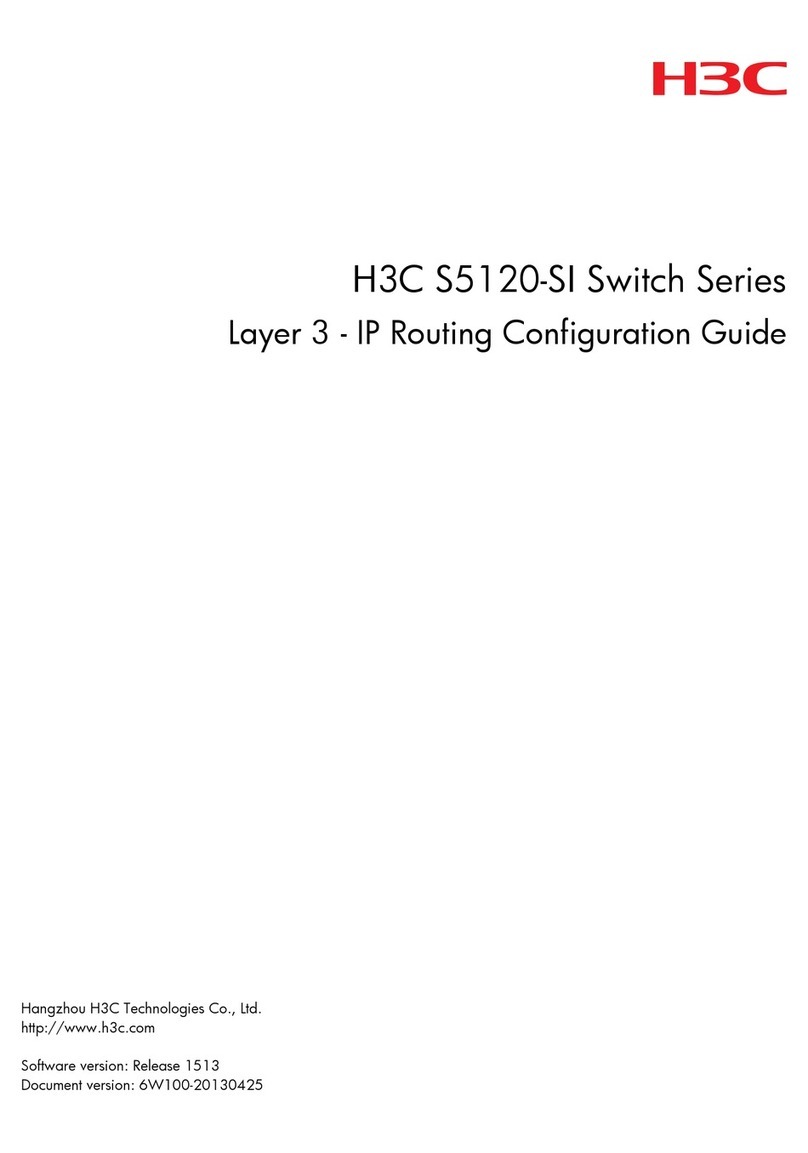
H3C
H3C S5120-SI Series User manual
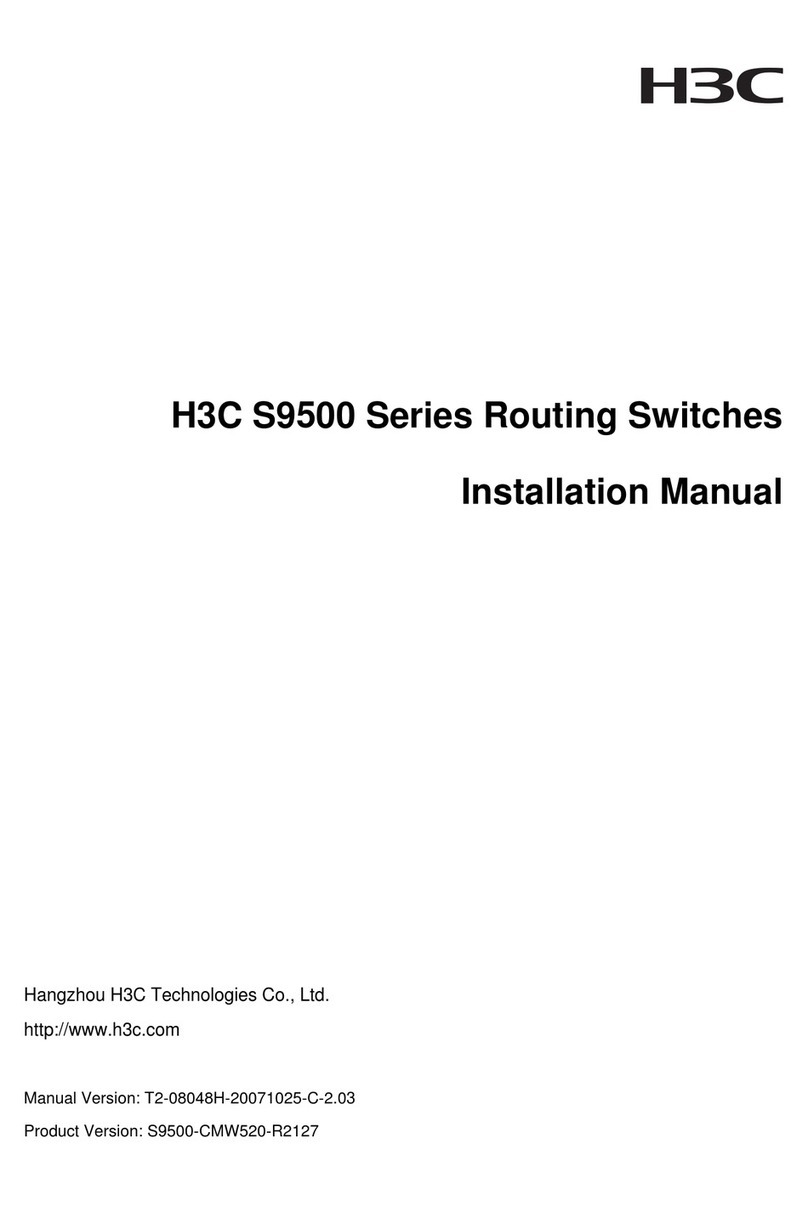
H3C
H3C S9505 SRP User manual
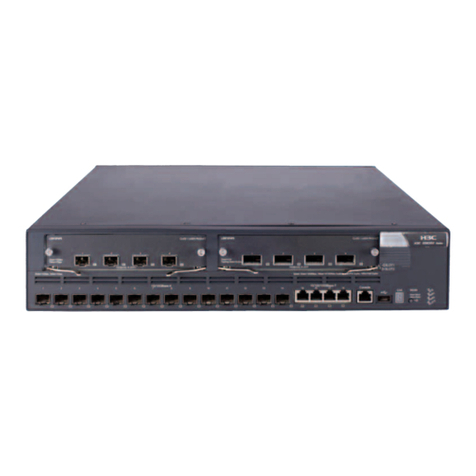
H3C
H3C S5820 series Installation manual
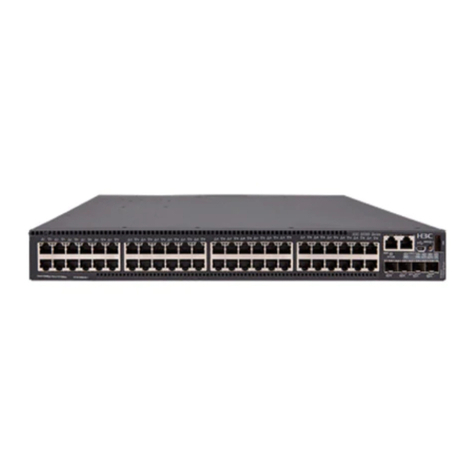
H3C
H3C S5800-EI Series User manual
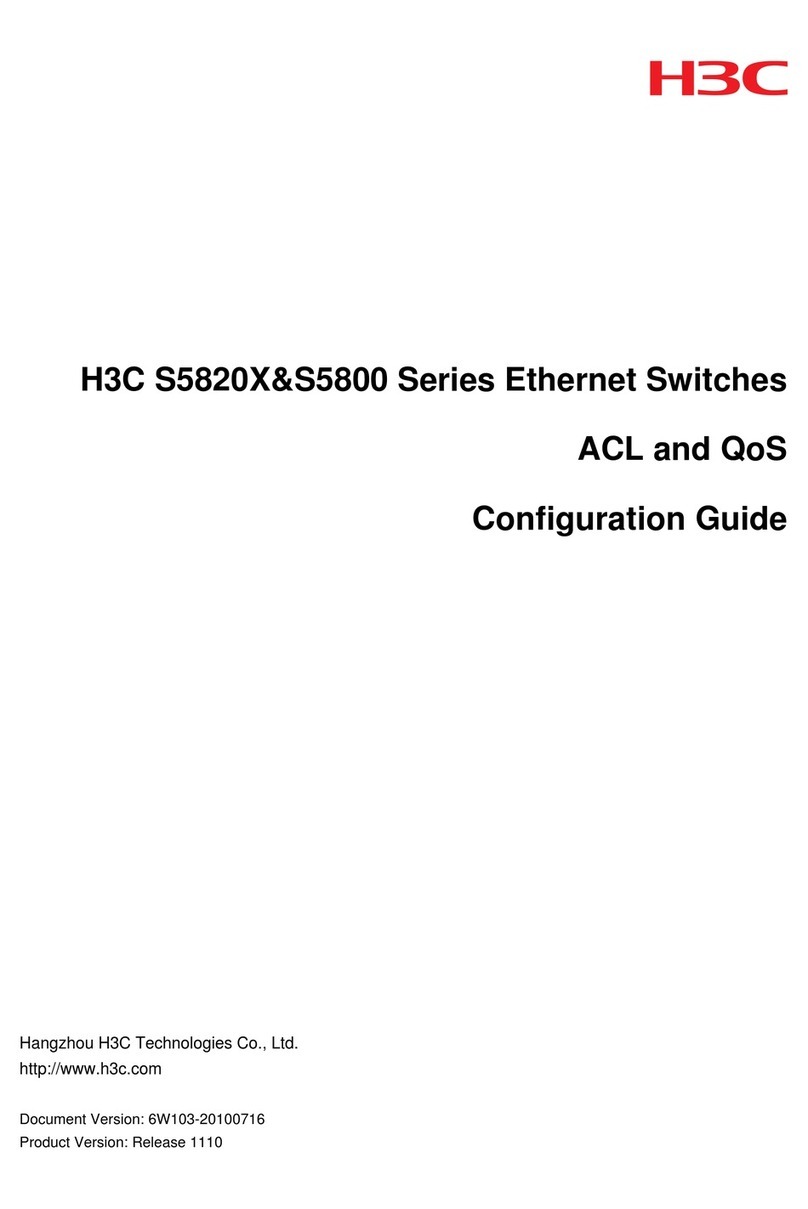
H3C
H3C s5820x series User manual
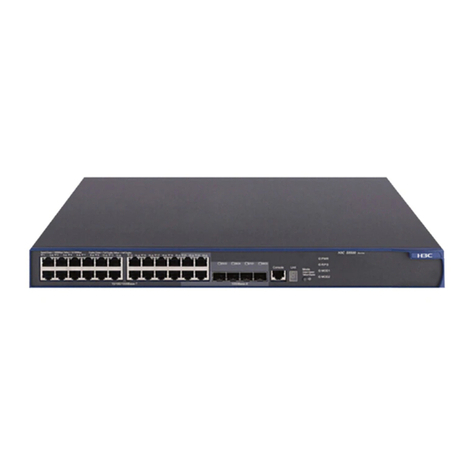
H3C
H3C S3610 Series User manual
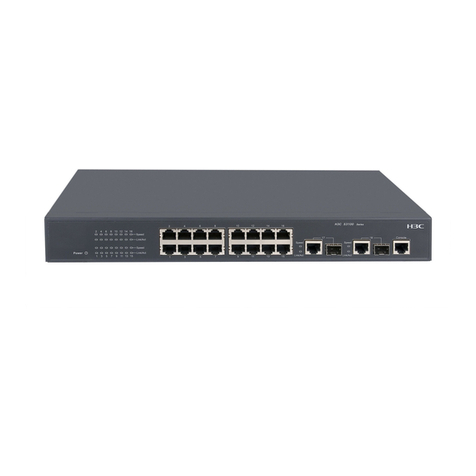
H3C
H3C S3100 Series Installation instructions
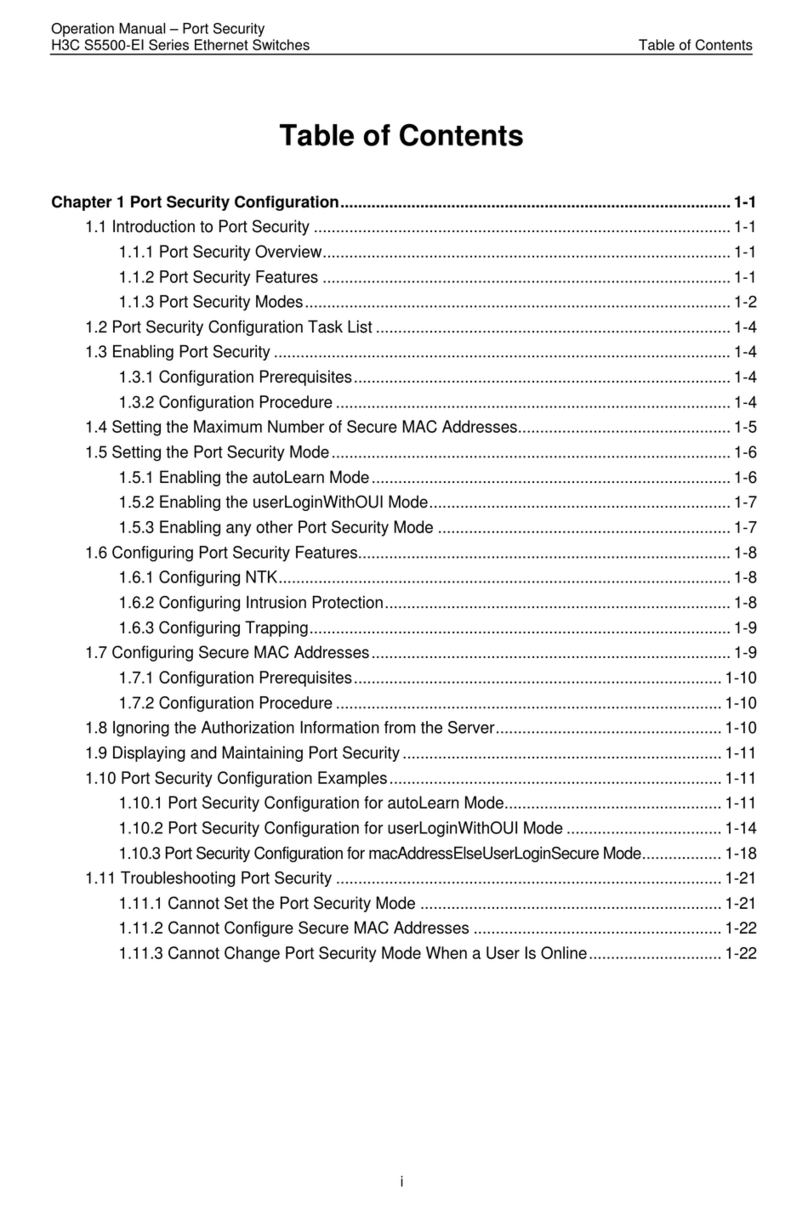
H3C
H3C S5500-EI series User manual
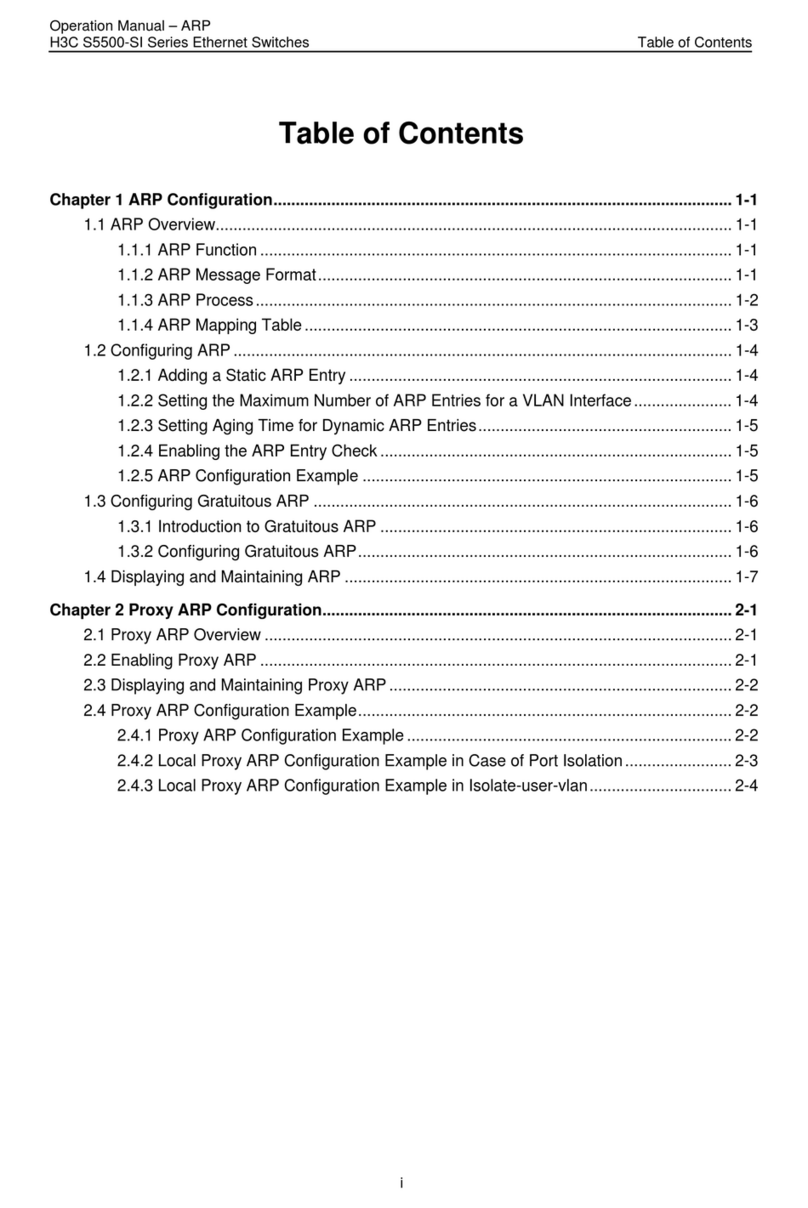
H3C
H3C S5500-SI Series User manual
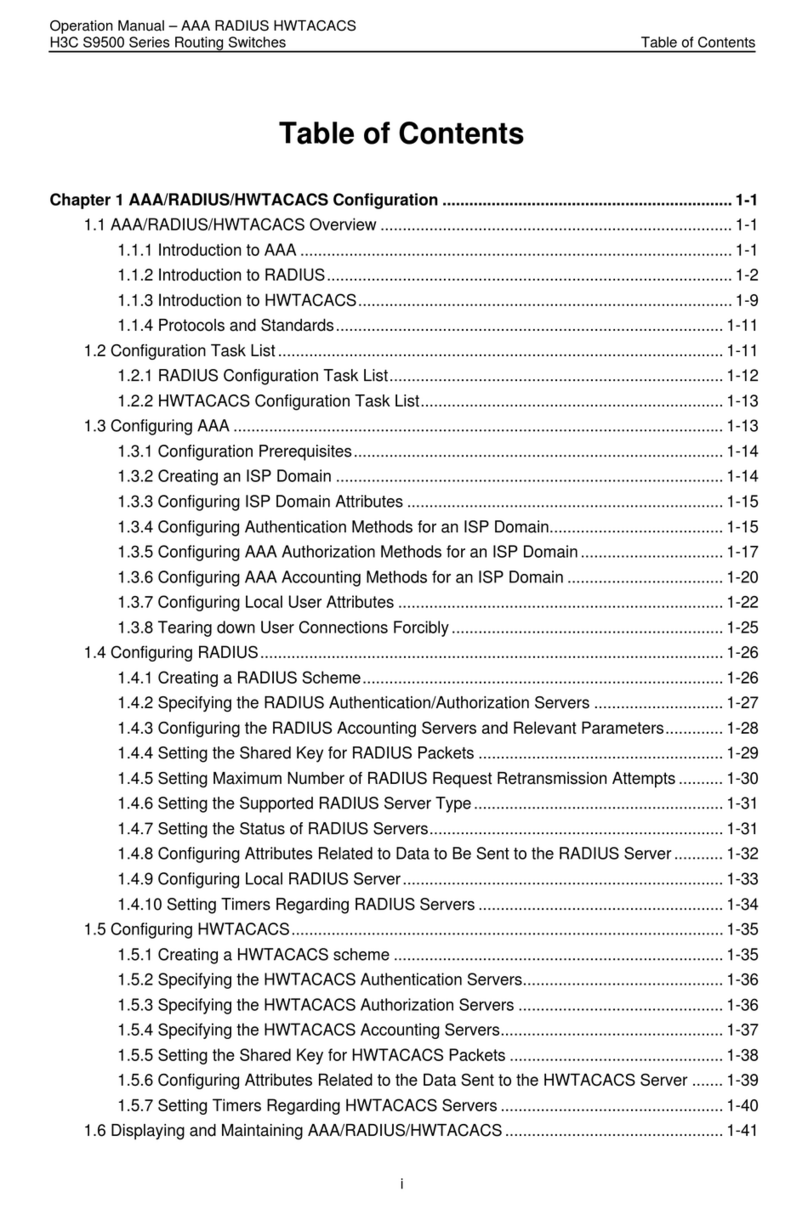
H3C
H3C S9500 Series User manual
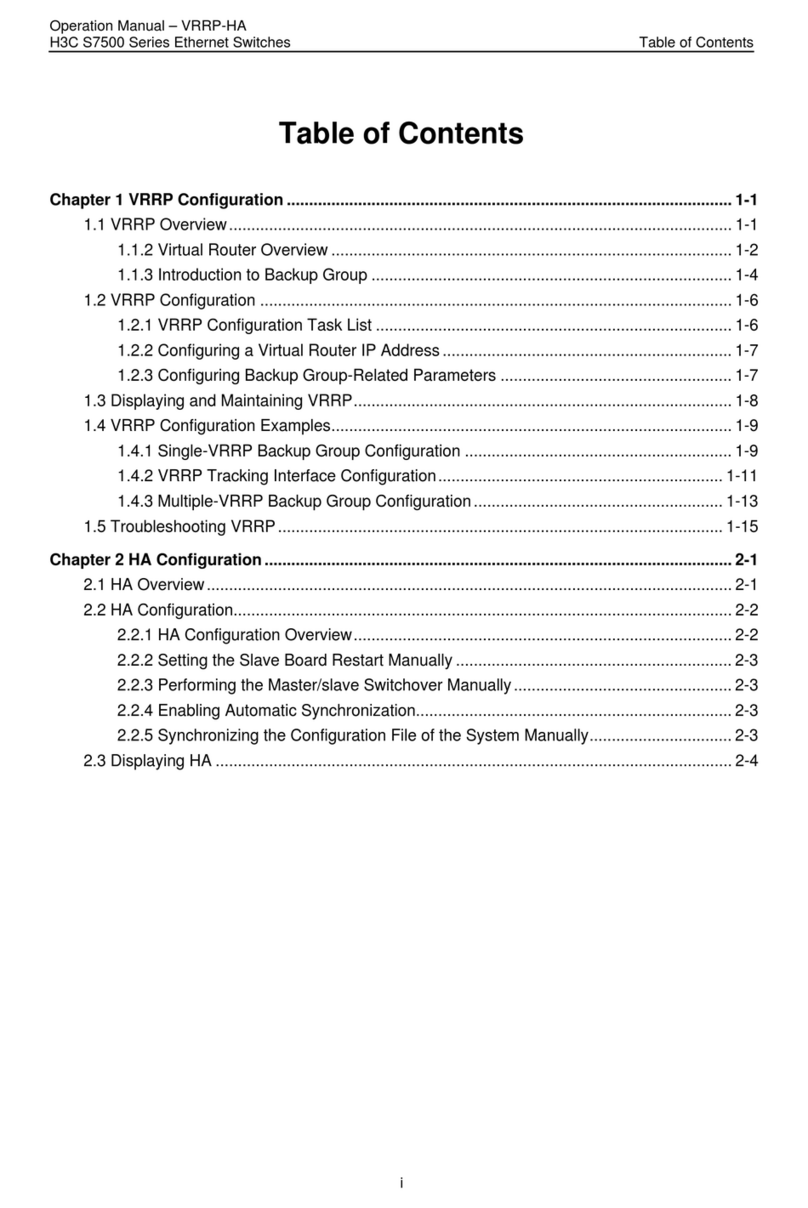
H3C
H3C S7500 Series User manual
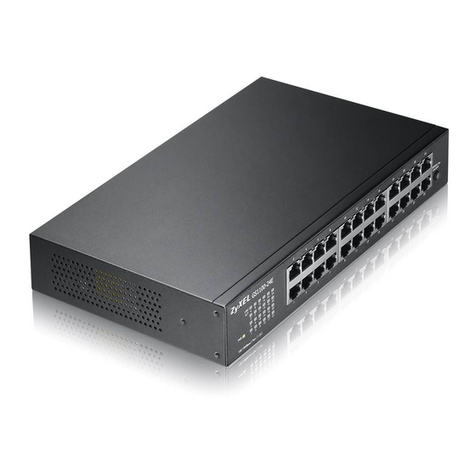
H3C
H3C S6850 Series User manual
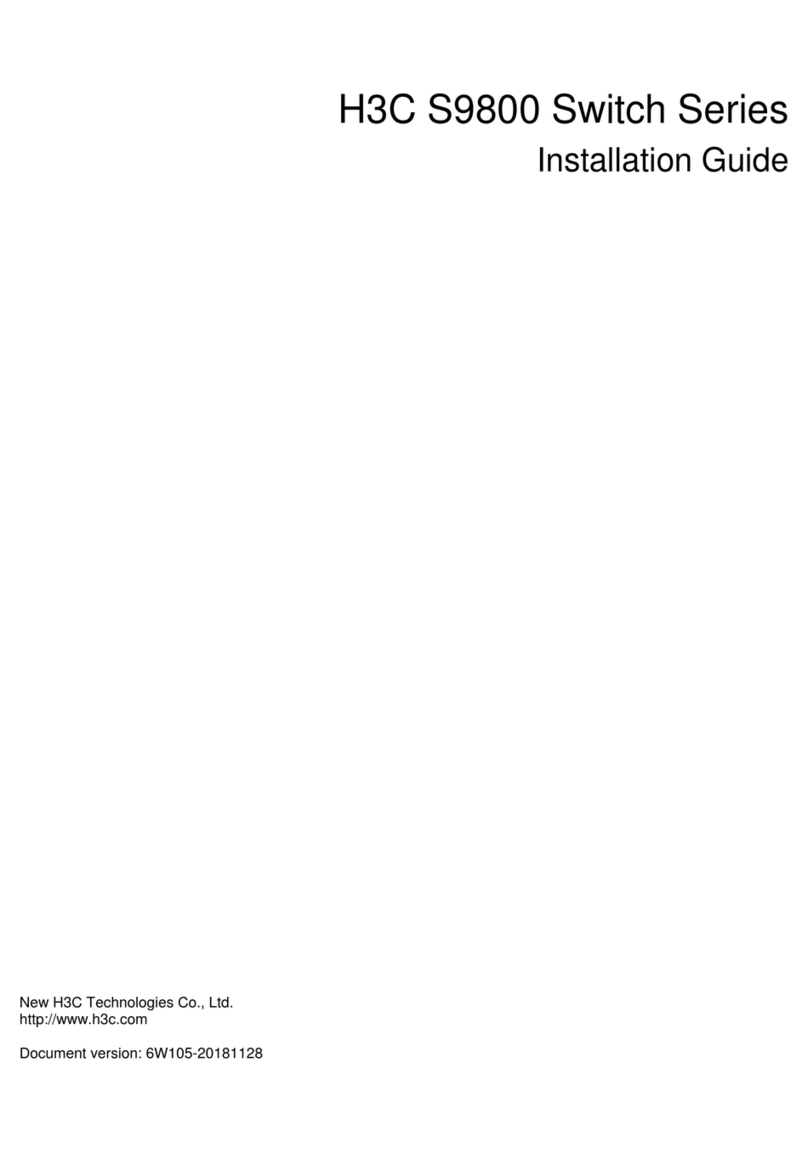
H3C
H3C S9800 Series User manual
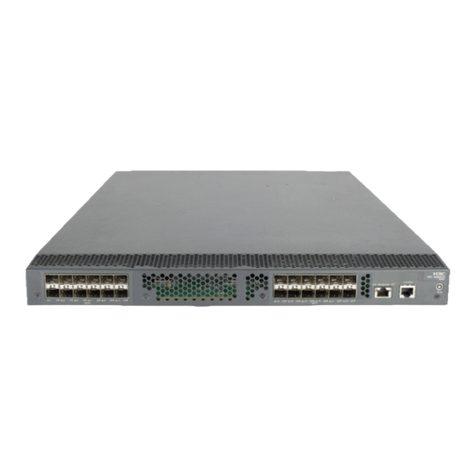
H3C
H3C S5830V2 series User manual
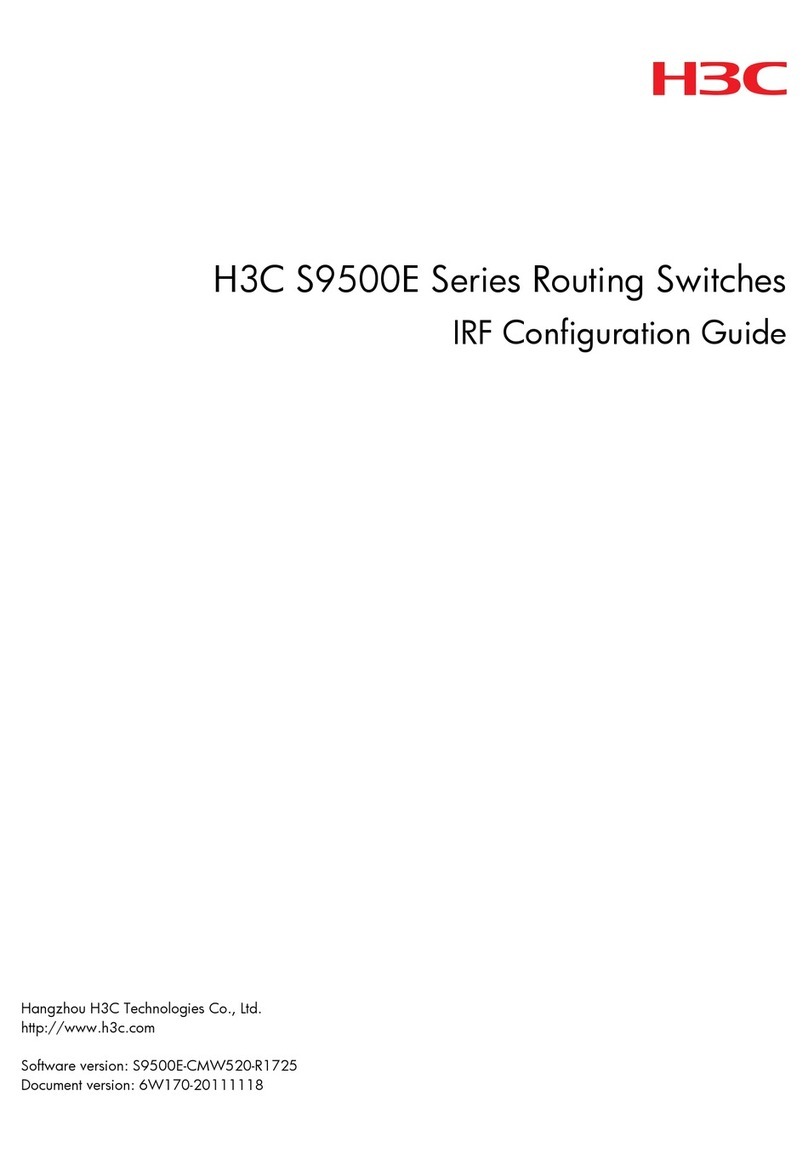
H3C
H3C S9500E Series User manual

H3C
H3C S5500-EI series User manual

H3C
H3C S5510 Series User manual
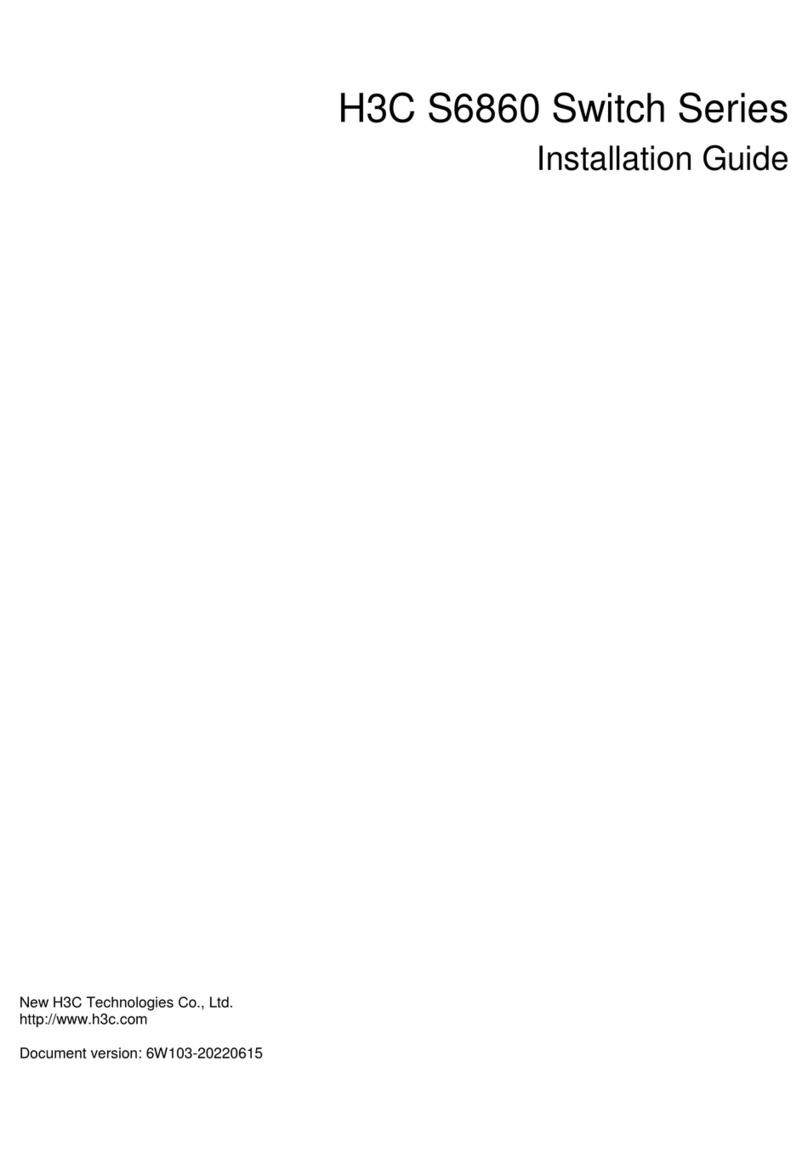
H3C
H3C S6860 Series User manual

H3C
H3C S3100 Series User manual

H3C
H3C S9500 Series User manual
